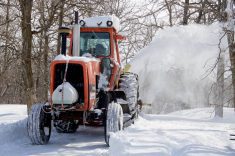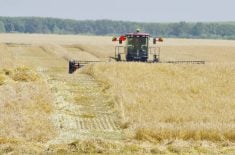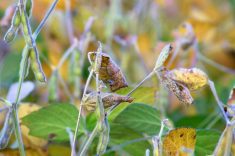Southwest Region
A few scattered showers in Southwest region amounted to 5 to 7 mm around Waskada and south of Riding Mountain National Park. Overall, it has been another dry and windy week. Most districts in the region did not get any appreciable rain.
Seedbed conditions are rapidly drying due to strong winds. Producers are trying to seed deeper but moisture is depleting quickly.
This coming weekends’ forecast looks very promising for rain, which will be a great help to the crops and forages.
Read Also

Seeding Indigenous agricultural prosperity
National Circle for Indigenous Agriculture and Food says Indigenous agricultural success needs strong relationships.
Spring wheat seeding is 90 to 95 per cent done and early seeded fields are germinating now. Barley seeding is 75 to 85 per cent complete. Oats are also 60 to 70 per cent complete.
Canola seeding is also progressing ahead, and 40 to 50 per cent crop has been seeded. Soybean seeding is 30 to 40 per cent complete. Corn is 60 to 70 per cent done with a few early fields starting to germinate. Field peas seeding is virtually done. Some early seeded fields are emerging nicely. Flax is also progressing with 20 to 30 per cent in the ground.
Winter cereals are coming along well. Most fields are at tillering stage. Producers are planning for herbicide spray as soon as winds allow. Overall seeding progress is estimated at 45 to 50 per cent in the southwest region.
Insect monitoring traps for diamondback moth are set up in the Southwest region. Trap count numbers are zero to very low at this point.
Minimal herbicide application to date. Surface-applied broadcast fertilizer can be seen on the fields due to lack of moisture preventing urea granules from dissolving and moving into the soil. New growth in alfalfa and grasses is starting to appear, but still slow due to lack of moisture and warmer temperatures. This coming week will give them a boost as temperature is rising.
Dugouts and sloughs are dry unless they have some feeder source. Just under half of dugouts are still holding water in them, and of those dugouts, only 20 per cent are full. Water in sloughs is also very low.
A lot of pastureland has been broken for annual crops this year, while bush and sloughs are pushed in to make more acres, since dry conditions allow access and crop prices entice farmers to make more production. Some properties are getting new or repaired fences (mostly old alfalfa land), so perhaps there is some land/crop rotation underway.
Cow and calves are still being kept close to corrals, and being fed supplemental feed and well-water, few of the them have been released onto pasture due to lack of fresh grass and water.
Northwest Region
Conditions this past week resulted in continued seeding progress throughout the Northwest Region. While daytime temperatures neared 25 C, cool overnight temperatures continued early last week dipping down as low as -7 C. By mid to late last week, overnight temperatures were warming and producer were able to move on to seeding more frost-sensitive crops. There were some localized, scattered showers but high winds have created increasingly dry soil conditions. Most areas still have adequate moisture in the root zone for cereals and peas however surface conditions are very dry, which could result in uneven canola germination. These dry conditions are also a concern for growth of pastures and hayfields. Dry conditions have resulted in burning bans in some municipalities in the region.
Spring operations are well underway throughout the region and producers are making rapid progress. Seeding is pegged at 60 per cent complete in the region to date with expectations of continued progress this coming week.
Wheat acres are wrapping up and are estimated at 85 per cent complete in the region. The warmer temperatures and good seeding conditions in the forecast should result in rapid progress this week. Spring wheat is emerging in good condition. Barley seeding is 40 per cent complete. Crops were seeded into adequate moisture for germination but more will be needed for continued growth.
Approximately 95 per cent of the peas are in the ground and rolled in the Roblin, Swan River and Dauphin areas. Peas are just starting to emerge.
With warmer weather and rain in the forecast for later in the week, seeding of canola is well underway. To date, approximately 40 per cent of forecasted acres are in the ground. Dry topsoil moisture is a concern for fast and even germination. There are a few acres of soybeans in the ground, but only about 5 per cent.
There has been good winter survival of winter cereals, clovers and alfalfa. Winter cereals came through the winter in excellent to good condition.
Forages are responding to warmer temperatures but significant moisture is needed soon. Pasture growth currently inadequate to turn out cattle for grazing and thus supplemental feeding is still occurring for many livestock producers. Corn silage seeding is progressing well. Dugouts are adequate, but will need additional moisture for recharge.
Central Region
Winds shifted predominantly from the north at the start of the week to mostly southerly as the week progressed. Daytime temperatures rose from below normal with overnight freezing to above normal, with highs reaching 30 C. Sunny skies prevailed; except for Friday when scattered shower activity brought trace amounts of 7 mm rain in isolated areas of the region. Topsoil is dry and moisture is usually found 3 inches deep or deeper. Precipitation is needed to replenish surface soil moisture for uniform seed germination, dissolve and incorporate fertilizer and soil active herbicides. The forecast this week begins with warm and sunny conditions that continue to dry topsoil but cooling with chance of showers for the latter part of the week. All farmers are anxiously awaiting a good, soaking rain at this point.
Field access was good and field operations continued this week. Soil temperatures at seeding depth currently ranging from 10 to 14 C. Soils have warmed, stimulating emergence of early planted crops that went into favourable moisture conditions.
Winter wheat, fall rye and perennial ryegrass fields are growing as temperatures have warmed. Development varies with some fall rye fields in the stem elongation stage. Rain is needed to support growth. Winter survival of those crops is good to fair with recovery somewhat delayed due to the poorer establishment conditions of the fall and cool conditions at the start of the season.
Field preparation ahead of seeding has been limited in an attempt to preserve topsoil moisture. Wheat, oats and barley seeding is considered done. Earliest seeded cereals have emerged, as moisture was favourable when those crops went in the ground. Stages vary from emerging to three leaves. Field pea seeding is considered almost done with early-planted fields emerging. Earliest canola fields are starting to emerge while some of the canola acreage remains to be seeded with about 65 to 75 per cent in the ground. Flax seeding is mostly done in the region, as is sunflower. Corn planting is estimated at 90 to 95 per cent done with some emergence reported but somewhat uneven due to the poor topsoil moisture. Some of the later planted crops have been put into dry soil and will remain dormant until rain comes.
Soybeans seeding picked up this week as temperatures rose.
Progress varies from about 65 per cent planted west of the escarpment and virtually finished in the Red River Valley. Land rolling of soybeans is occurring. Dry bean seeding started and progressing well with 30 to 40 per cent done in the Portage area. Potato planting is about 95 per cent done with some of the earlier planted fields emerging. Irrigation is being applied where hills are dry. No emergence issues so far. Good sprouts are developing and warm temperatures to stimulate emergence.
Overall seeding in the region is considered to be in the 85 to 90 per cent completion range with a higher proportion done in the Red River Valley.
Weed growth is evident with warmer temperatures. Minimum amount of pre-seed burnoff to date given the poor weed growth but more is expected as conditions changed.
Pheromone baited traps for diamondback moth and true armyworm, potential pests of canola and cereals respectively, are setup to monitor their arrival from southern latitudes. Very low counts reported in the region of either pest so far. Flea beetle activity on canola is evident with some control measures applied where needed.
Since groundwater and wells did not recharge this spring, a few yard wells are going dry forcing producers to haul water or move livestock. With dugouts lower than normal to start the grazing season, there is concern how long the water will last into the summer. Cattle being moved out of winter-feeding areas onto sacrifice pastures still require feeding before grazing can begin. Hay and pasture forage growth has improved but needs moisture to continue advancing.
Eastern Region
Limited precipitation accumulation ranging from zero to 8 mm was recorded over the last week, with a few isolated showers accumulating as much as 15 mm. Average soil temperatures at seeding depth were recorded at the 12 to 15 C mark. Soil moisture conditions on cropland across the region were rated as 50 to 70 per cent adequate and 30 to 50 per cent short. Daytime and nighttime temperatures quickly moved from normal to well above normal during the reporting period, which drove rapid emergence of earlier seeded crops.
Rapid seeding progress over the reporting period with the focus being canola and soybeans. Producers are still being careful about drying out seedbed and especially so where shallow-seeded crops are going into lighter soils. A few producers reported stopping seeding of canola and soybeans due to very dry seedbeds at seed depth. They are waiting to see what the coming weather brings for moisture and feel there is still time left to seed into late May and early June. Others either have adequate seedbed moisture or are choosing to place seed in the dust in anticipation of rain. All producers would like to see at least an inch of rain but more would be welcomed.
Herbicide applications on winter cereal stands have been completed. Pre-emergent spraying is in full swing when the wind allows, emerging cereals are driving the need for weed control. Producers remained concerned about even crop germination and emergence. Once the crop is started, subsoil moisture will be able to carry it for several days, but surface moisture is a concern. A significant rain in May will be critical to crop success.
Across the region, less than 5 per cent of winter wheat or fall rye acres appear to have winterkilled. Overall, stand condition is assessed as good with stands tillering and growing well.
Excellent seeding progress was reported across the Eastern region. Canola and soybeans were the main seeding focus this past week. Spring wheat seeding is complete and is emerged and beginning to tiller. Oat planting is complete and emerging. Corn acres continued to be sown this past week, planting is estimated at 95 per cent complete. Field pea planting is estimated 100 per cent complete and is emerged. Sunflowers are estimated at 100 per cent complete. Flax seeding is complete with 50 per cent emerging. Canola is estimated at 75 per cent complete with 5 per cent emerging. Soybean planting is estimated at 85 per cent complete. Canola and soybeans planting is expected to wrap up this week, weather dependent.
Hay and pasture soil moisture conditions in southern parts of the region are rated as 50 per cent adequate and 50 per cent short. Very dry conditions continue, with some scattered thunderstorms throughout the district on the weekend but no significant rainfall amounts. Pasture conditions are not improving as more and more cattle are moved onto pasture. Supplemental feeding is still needed in areas where surplus feed has run out.
In northern parts of the region hay and pasture condition of stands continued to deteriorate from last reporting period. Producers are disappointed with slow growth of stands due to overnight frosts. Some improved growth as things have warmed up this week but pastures remain at least two weeks behind of where they should be at this time of year. Hay stands are behind normal development, but not quite as much as pastures. Cattle producers are holding back hay for anticipated feeding on pasture given they want to release their cows on or around June 1.
Producers are concerned about further deterioration of pasture conditions because of inevitable over grazing. Alfalfa seems to have overwintered well in hay stands with good populations of live plants observed. Persistent past cool growing conditions a bigger problem right now than soil moisture status on hay stands and pastures but moisture stress starting to be noticed in stands on lighter soils. The few dugouts in the area are only about 60 per cent full. Available livestock water is rated at 100 per cent adequate.
Interlake Region
Dry conditions continue, with some hope for significant moisture in the forecast. Although still variable, temperatures jumped, with highs ranged from 26 to 29 C, and overnight lows down to -8.5 C. Daily averages now range from 11 to 13 C, up from last weeks’ 2 to 4.4 C.
Scattered isolated showers this past week, with most weather stations reporting 2 mm or less. Scattered showers earlier, or good rains last season, have allowed some to seed into moisture at 1.25 to 1.5 inches. Some producers have seeded deeper into moisture. More reports of no moisture at all, down to 2 inches and deeper, particularly on lighter textured soils. Topsoil moisture is still adequate on many acres, but there are more reports of small seeded crops sitting in dry soils. Soil moisture continues to decline across the region, sped up by with field operations. Significant precipitation will be necessary for recharge.
A dramatic increase in seeded acres has occurred with warmer weather. Significant fertilizer applications and tillage operations last fall have allowed for excellent progress as conditions allow. Progress is more advanced in the south Interlake. Overall, seeding completed for the region ranges up to 65 per cent and higher. Areas further south report 80 to 85 per cent complete.
Quite a number of producers have completed seeding.
There has been a rush on spreaders to get fertilizer onto hay and pasture before the forecast rains. Winter survival has been good; reports of winterkill across the region have been less than 5 per cent. Hay and grass seed fields are very slowly greening up, but with very little new growth.
Most estimate 85-95 per cent of the cereals are in. Wheat is emerging up to two leaves, with a few reports of early 3-leaf stage. There is little difference in stage between the earliest seeded wheat and that seeded two weeks later. Emergence is fairly even, with some patchiness in the very earliest seed fields. Peas are in, and some have emerged nicely. Barley is emerging, and oats are close behind.
There has been a lot of switching around of seeding order of crops, due to the dry conditions. Some canola has gone in, others are waiting until soils warm, to encourage rapid emergence. Flea beetle pressure is expected to be high, and producers are factoring that concern into their decisions. Many are concerned about seeding into soft, dry soil, and are deliberating how long to wait for rain. Some are waiting until after this weekend’s impending rain. Some are choosing to seed soybeans first, as they are able to go in deeper, while others are splitting up the canola and soybeans. The traditional order of seeding – cereals, canola, then soybeans was disregarded this year. Canola is estimated as 60 to 70 per cent complete, and soybeans at 50 to 80 per cent done. Canola is germinating, with some rows of cotyledon stage plants noticeable. Soybeans are germinating, and a rain would see lots of emergence.
Most corn is seeded. Sunflowers are close to complete. Other small seeded crops such as flax and forage seed crops are being seeded. Smaller seeded crops are going into dry soil, in places. Some changes have been made due to dry conditions, with some forage seed crop acres are going to canola. Concern regarding lack of moisture lower in the soil profile continues. Field operations are drying out the topsoil. More producers have moved to low disturbance seeding equipment, and many have changed their traditional spring practices to conserve moisture. Strong winds continue to dry the soil, and dust clouds behind field operations is obvious.
There seems to be few if any changes to seeding intentions. Acres are generally holding, and producers are optimistic with good market prices and if they have enough topsoil moisture to get the crop growing. Some indications of late changes, mostly due to attractive commodity prices.
Pre-seed soil applied herbicides applications have been made when conditions are appropriate. Some changes have been made due to dry conditions. More pre-seed and pre-emergence burnoff applications are undertaken as weed growth has increased; but will soon be out of stage. More winter annuals and dandelions are evident. Wild oat patches are growing well. Volunteer cereal growth is significant in places, a result of last fall’s strong winds shelling out mature standing crop, prior to harvest. Winter annuals are also using up valuable moisture.
Pheromone baited traps have been set up for monitoring diamondback moth and true armyworm. Nothing found in all but one trap again this week; two diamondback moths found.
Although forages are greening up, dry conditions continue to limit pasture and hay regrowth. Combined with late summer and fall grazing, plants have low carbohydrate root reserves for from which to regrow. At present, winter feed supplies are adequate for most, but more concern is being raised about delays to cattle going on to pasture. Some producers are buying feed. Winter forage supplies were improved this past winter as compared to the previous year. Producers switched from annual cash crops to feed crops to make up anticipated shortfalls. Silage and greenfeed acres have increased again this year.
Livestock water supplies are currently adequate for most, but concern about lack of supply is increasing. Dugout levels are low for this time of year, with more reports of being completely dry. More reports of well drilling to secure water availability.














